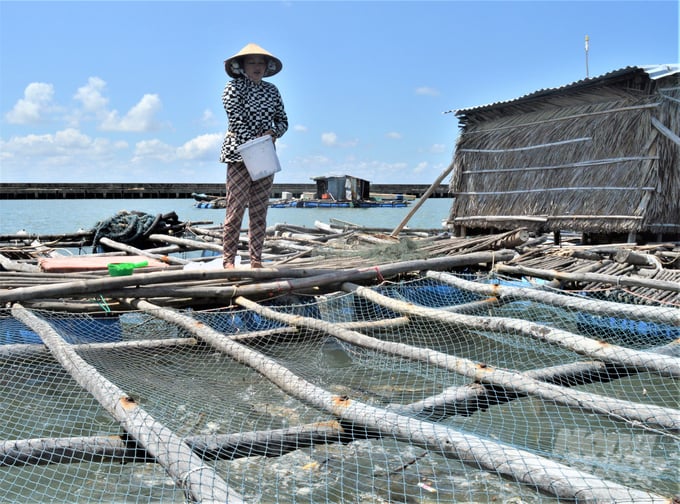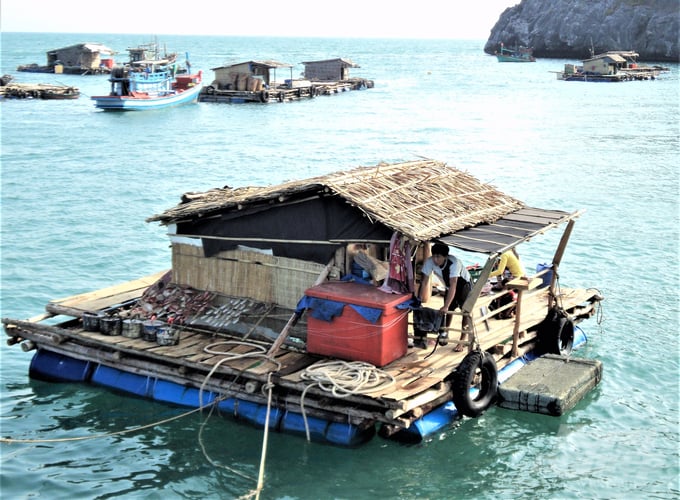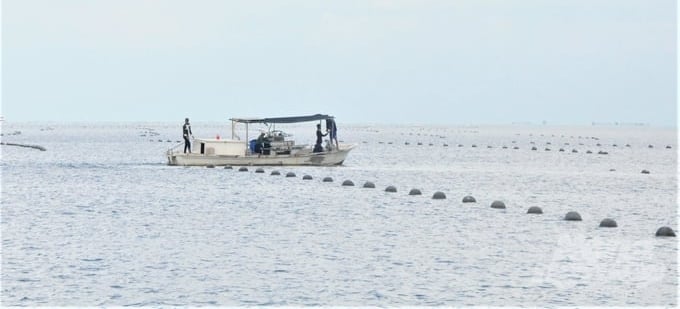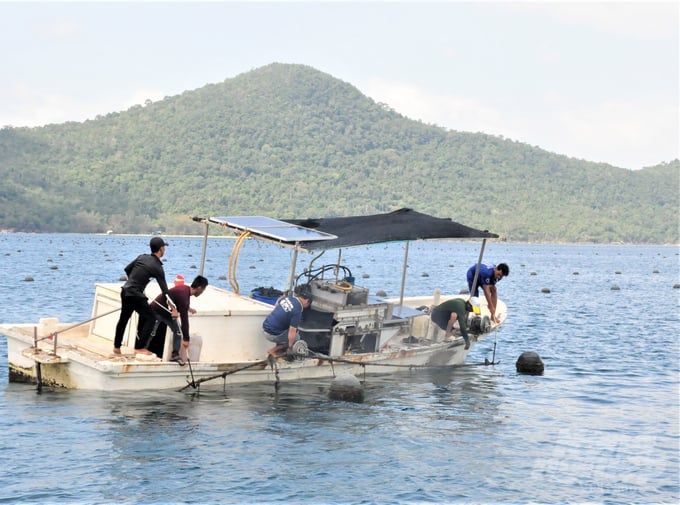May 29, 2025 | 03:17 GMT +7
May 29, 2025 | 03:17 GMT +7
Hotline: 0913.378.918
May 29, 2025 | 03:17 GMT +7
Hotline: 0913.378.918
Kien Giang, a coastal province in western Vietnam, boasts over 200 kilometers of coastline and more than 140 islands. The province's waters, covering approximately 63,290 square kilometers within the Gulf of Thailand, feature multiple sheltered bays with moderate depths and minimal storm activity, resulting in ideal conditions for the development of mariculture. The province is focusing on effectively utilizing its marine and island advantages in order to develop a modern mariculture sector, and transform Kien Giang into a national marine economy center, as outlined in recently established local plans.
Local fishermen are engaged in mariculture along the length of Kien Giang's extensive coastline, most notably around inhabited islands. Wooden cages are densely packed in favorable mariculture sites, typically supported by empty plastic barrels for buoyancy. Fishermen build small huts on these rafts to facilitate the care and protection of fish.

Despite Kien Giang's vast mariculture potential, the majority of local fishermen rely on small-scale farming activities and improvised wooden cages, resulting in low productivity and economic efficiency. Photo: Trung Chanh.
To Diem Thuy, an experienced cage mariculture farmer from Hon Tre Island, Kien Hai District, reported that her family currently manages 20 cages containing various fish species after several years of investment. Depending on market demand, local fishermen invest in high-value fish species such as cobia, pearl grouper, golden pompano, greater amberjack, red drum, barramundi, among others. With a stable market, mariculture typically yields a profit margin of 25 to 30% over investment costs.
Thuy noted that the majority of households on Hon Tre Island utilize wooden cages for mariculture, which are susceptible to damage. Consequently, local fishermen require preferential policies, including state-supported low-interest loans or installment payments to invest in modern HDPE cages. This initiative will facilitate mariculture in offshore areas with higher water quality, fewer disease outbreaks, higher productivity, and improved economic returns. Additionally, the granting of long-term marine area leases will encourage fishermen to invest in sustainable mariculture development.

Kien Giang fishermen primarily utilize wooden cages, supported by empty plastic barrels for buoyancy, to engage in mariculture activities. These cages are typically combined with rafts that house small huts that facilitate the care and protection of fish. Photo: Trung Chanh.
According to Nguyen Sy Minh, Deputy Director of the Kien Giang province's Sub-Department of Fisheries, Kien Giang's agricultural sector plans to develop 4,000 mariculture cages with an output target of 4,400 tons in 2024. Additionally, the province will allocate 23,300 hectares to mollusk farming activities, prioritizing sea clams, blood cockles, green mussels, and undulated surf clams, with an expected yield of 96,600 tons. The province also aims to cultivate pearls, oysters, and spotted Babylon snails.
During the first quarter of 2024, Kien Giang fishermen stocked aquaculture species across 236,080 hectares, including 128,333 hectares for brackish water shrimp with 2,991 mariculture cages, 18,051 hectares for mollusks, and 68,483 hectares for sea crabs, with the remaining area used for pond, field, and cage aquaculture. Accordingly, the province's total aquaculture harvest reached nearly 40,500 tons, primarily consisting of raw shrimp, sea fish, mollusks, and sea crabs.
However, the current level of development is relatively low compared to the goals of Kien Giang's sustainable mariculture development plan until 2030. Namely, the plan targets 6,800 mariculture cages with a production of 21,460 tons in 2024. Similarly, the plan sets a target of 26,310 hectares with a yield of 83,844 tons for mollusk farming.
Kien Giang province's Sub-Department of Fisheries has identified several challenges within the province's mariculture development. Accordingly, local fishermen primarily utilize traditional wooden cages for mariculture activities, which resulted in low productivity. The allocation and arrangement of marine areas for cage mariculture have been delayed compared to the provincial plan. On the other hand, the province is unable to establish a value chain for mariculture; and the infrastructure for mariculture is lacks consistency. The implementation of policies to attract investment and support for mariculture development is limited.
According to Kien Giang's sustainable mariculture development plan until 2030, designated mariculture areas include Hon Nghe and Son Hai islands in Kien Luong district; Hon Tre, Lai Son, An Son, and Nam Du islands in Kien Hai district, Tien Hai island in Ha Tien city, and Tho Chau island in Phu Quoc city. Subsequently, local governments will issue licenses for mariculture; and fishermen will be required to register their cages and primary mariculture species.

Kien Giang is focusing on effectively utilizing its marine and island advantages in order to develop a modern mariculture sector, with the goal of becoming a key player in the marine economy. Photo: Trung Chanh.
The province is allocating resources to develop mariculture into a large-scale, industrial, efficient, sustainable, and environmentally friendly sector. Efforts include attracting businesses to invest in industrial mariculture and creating branded products. Additionally, fishermen are encouraged to transition from traditional wooden cages to HDPE cages, which increase productivity, improve economic efficiency, and raise incomes for coastal communities. This transition also contributes to the protection of national security and defense in marine and island areas.
Quang Trong Thao, Deputy Director of Kien Giang province's Department of Agriculture and Rural Development, emphasized that coastal, island districts and cities must complete over 50% of the task of allocating marine areas to local households and facilities for cage mariculture by 2024. Furthermore, at least 90% of the local facilities must acquire cage mariculture certificates (identification numbers) after receiving their correspoding marine areas. Additionally, over 80% of the local facilities are expected to receive aquaculture licenses in accordance with regulations.
The local agricultural sector is focused on organizing production and managing mariculture in a concentrated and sustainably linked manner. Moreover, the Sub-Department of Fisheries aims to support local districts and cities in sustainably organizing and managing mariculture activities in association with the allocation of marine areas and the issuance of identification numbers for cage mariculture facilities. The Sub-Department is also actively encouraging farmers to participate in production linkage chains through cooperatives and cooperative groups. This approach aims to reduce costs, facilitate support in production and product consumption, and promote the exchange of farming experiences and techniques.

Kien Giang is actively allocating marine areas to fishermen, with the aim of developing mariculture into an efficient, sustainable, and environmentally friendly sector. Photo: Trung Chanh.
The Kien Giang Agricultural Extension Center is enhancing its efforts in promoting aquaculture, providing training and instructions to fishermen on aquaculture techniques, with a focus on industrial mariculture. The center is establishing models for mariculture using new technologies, such as HDPE cages and reinforced mesh cages. Additionally, it is guiding the implementation of safety measures for cages and laborers involved in mariculture, with the goal of effectively responding to adverse weather conditions such as rain and storms.
The province is focusing on raising awareness among organizations, communities, and individuals regarding the importance of developing industrial mariculture. Accordingly, the province is promoting and expanding successful mariculture models, with a focus on models that utilize industrial feed instead of trash fish; thereby contributing to the protection of aquatic resources and the environment, creating high-value products, and promoting green development.
Kien Giang province's Sub-Department of Livestock Production and Animal Health is enhancing disease prevention efforts for sea fish raised in cages. Namely, the Sub-Department conducts regular health inpsections on aquaculture breeds imported into the province; and monitors for signs in infectious diseases in aquatic animals in order to establish effective preventive and treatment measures.
Kien Giang province is supporting its fishermen in transitioning from aquaculture using ineffective traditional nearshore cage and inshore, offshore fishing; to modern mariculture using HDPE cages and offshore industrial mariculture. This transition aims to utilize the province's potential to create significant production value; thereby promoting sustainable economic development, and reducing pressure on fisheries resources.
Translated by Nguyen Hai Long
/2025/05/25/4127-3-073637_820.jpg)
(VAN) Thanks to the promotion from an FAO-implemented project, vegetable production in greenhouses in Moc Chau has seen strong development, from 1.5 hectares in 2021 to nearly 50 hectares in 2024.

(VAN) FAO has recently supported USD 140,000 to implement the project 'Risk mitigation human-animal interface risks through disease control initiatives in pig farming.'

(VAN) The People's Committee of Tra Vinh province has approved an adjustment to the investment policy for the Green Hydrogen Plant project, increasing its area to approximately 52.76 hectares.
![Reducing emissions from rice fields: [2] Farmers’ commitment to the soil](https://t.ex-cdn.com/nongnghiepmoitruong.vn/608w/files/news/2025/05/05/dsc08881jpg-nongnghiep-140632.jpg)
(VAN) Clean rice cultivation model in Thuong Tan commune, Bac Tan Uyen district, is assisting local residents in achieving sustainable agriculture by substantially reducing costs, increasing productivity, and protecting the environment.

(VAN) At the conference to disseminate Resolution No. 68, AgriS introduced its digital agricultural ecosystem and reaffirmed its commitment to accompanying the Government in promoting private sector development and sustainable agriculture.

(VAN) 'Blue Ocean - Blue Foods' initiative is designed to restore marine ecosystems and establish sustainable livelihoods for local communities by cultivating a minimum of 1,000 hectares of cottonii seaweed in the first three years.
/2025/05/21/4642-3-112707_603.jpg)
(VAN) The V-SCOPE project has made direct contributions to three out of six pillars of the Comprehensive Strategic Partnership between Vietnam and Australia.